UNESCO Chair
UNESCO Chair on Management and Promotion of World Heritage Sites: New Media and Community Involvement
The primary purpose of the UNESCO Chair is to improve the “Sustainable World Heritage Management.” The World Heritage Strategic Objectives address the five fundamental concepts called 5C (Credibility, Conservation, Communication, Capacity-building, and Communities). The UNESCO Chair established at Kadir Has University aims to deliver capacities for Sustainable World Heritage Management that develops new technologies to create bindings between science, science, community, and culture. Heritage management is destined to fail to be sustainable without the driving force of communities. Therefore, there is a great demand to find ways to engage communities in the respective management mechanisms. Through academic research, educational programs, and other methods, the UNESCO chair will help the management and global-wide promotion of the world heritage sites and deliver “exemplary practices” therein using new and innovative technologies.
Acting in cooperation with the respective local administrations and national and international non-governmental organizations and expert private institutions, including the UNESCO Turkish National Committee, the UNESCO Chair ensures the contribution of academicians.
UNITWIN (University Twinning and Networking / UNESCO Chair Program, commenced in 1992, encourages cooperation and networking among international universities to increase their capacities through knowledge sharing and collaboration. The Program supports the establishment of UNESCO Chairs and UNITWIN Networks in key priority areas (education, natural and social sciences, culture, and communication).
The UNITWIN / UNESCO Chair Program covers academic education, research, and exchange and provides a platform for knowledge sharing in any areas within the extent of responsibility of UNESCO. As of November 2014, there are 648 UNESCO Chairs in 126 countries worldwide.
50 chairs focus on culture, 13 of which specialize in Cultural Heritage. Three chairs focus on the field of World Heritage. The chair established at Kadir Has University is the fourth chair that focuses on the World Heritage.
Kadir Has University UNESCO Chair will serve as a think tank to find new ways to produce knowledge on the protection and sustainable improvement of the World Heritage and engage the communities in the management mechanisms. The results of this Program are intended to help promote the World Heritage Sites for Turkey and offer exemplary practices in the region to that end. Kadir Has University UNESCO Chair will serve as a center to facilitate information transfer inside and around the borders of Turkey.
The UNESCO Chair at Kadir Has University is intended to build capacities at different academic levels. It makes an effort to better manage the world heritage by gathering other educational institutions, non-governmental organizations, and private enterprises.
“It is one of the most challenging difficulties to overcome in developing countries to mention the problematic aspects of social engagement and inclusion regarding the World Heritage Management. However, the new media gives opportunities through pluralistic and independent (and free) mechanisms of knowledge sharing.”
UNESCO Chair
Prof.Dr.E.Füsun Alioğlu
Administrative and Academic Committee of UNESCO Chair
Coordinator
Prof. Dr. Banu Manav
Academic Team
Assoc.Prof.Dr. Zeynep Günsur
Asst.Prof.Dr.Öğretim Üyesi Özlem Hemiş
Asst.Prof.Dr.Burcu Çiğdem Yılmaz
Asst.Prof.Dr.Mine Koyaz
Tania Daphne Feldzer Şan, M.Sc
Secretariat
Tania Daphne Feldzer Şan,M.Sc
You can contact Kadir Has University UNESCO Chair at unesco@khas.edu.tr.


Events & News
Delaminating Istanbul is part of the AAA Study trip for “Transformation, Cities and Buildings.” In September, we visited Istanbul, where the weather was pleasantly warm and the city was quieter than during the bustling summer tourist season. Our exploration focused on the intricate urban and architectural developments spanning various eras, including the Roman, Byzantine, Ottoman, and Turkish periods.
Our second-year students engaged in a deep mapping process, building on the foundational knowledge gained in the first week of the course. This enabled them to uncover the complex, interwoven layers of this complex city and to delineate their individual insights at both urban and architectural scales. They gained valuable perspectives on Europe’s largest and rapidly evolving metropolis, contributing meaningfully to the ongoing researches at the UNESCO Chair at Kadir Has University.
We collaborated closely with the Kadir Has University UNESCO Chair, which aligns with our focus on transformative practices. Centered on the historical peninsula, a UNESCO World Heritage archaeological site, our students had the unique opportunity to visit the Boukoleon Palace, which was opened exclusively for us with logistical support from the Istanbul Metropolitan Municipality. This experience was enriched by the expertise of Prof. Dr. Banu Manav (Dean of the Faculty of Art and Design), Prof. Dr. E. Fusun Alioglu (the UNESCO Chair), and M. Architect Ayşen Kaya (IBB Heritage), who shared their insights on this remarkable site.
We invite everyone interested in the outcomes of the course to join us on October 11th at Project Room 1 (Level 1/AAA) at 13:00. Attendees will have the opportunity to explore our interactive DEEP MAP, showcasing the delaminated layers of both the Boukoleon Palace and the Historical Peninsula, as well as additional FUTURE LAYERS proposed to enrich everyday life for local residents.
The news can be followed on:
UNESCO Chair page (https://www.khas.edu.tr/en/unesco-chair/)
Kadir Has university FB page: (https://www.facebook.com/watch/?v=518195744260642&rdid=XvS1Cm2Ulmubr3rp)
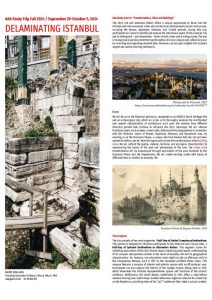

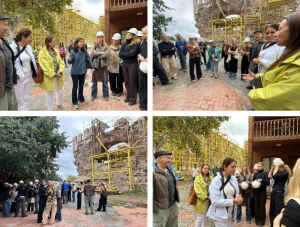
Danimarka, AARHUS Üniversitesi Mimarlık Bölümü (Aarhus School of Architecture) öğrencilerinin Doçent Naime Esra Akın yürütücülüğünde, 2024-2025 Güz Yarıyılı dönem projeleri çerçevesinde 29 Eylül-5 Ekim tarihleri arasında İstanbul’a yapacakları teknik geziye UNESCO Kürsüsü ile Sanat ve Tasarım Fakültesi ev sahipliği yapacaktır. Prof.Dar. Banu Manav, Prof.Dr.E.Füsun Alioğlu ve Kültür Varlıklarını Koruma Doktora Programı öğrencisi Y.Mimar Ayşen Kaya bu programa katkı sunacaktır.
Kadir Has University is leading an international project on preserving industrial heritage to encourage the exchange of knowledge, experience, and innovation.
The project CONSIDER: Sustainable Management of Industrial Heritage as a Resource for Urban Development has secured almost 1.2 million Euros from the European Union Horizon 2020 RISE Program. Universities, municipalities, city councils, conservation trusts, and heritage sites from several European and Middle Eastern countries are project partners.
CONSIDER will start in October 2021 and last four years. The project aims to research experiences gained in the EU countries and elsewhere, developing and sharing innovative ideas for preserving the industrial heritage and its sustainable integration into modern urban life.
The industrial heritage is an aspect of its cultural heritage and forms a part of a location’s identity. In the long run, abandoned buildings and sites can mean irreparable loss. Preservation and sustainable integration of the industrial heritage into modern urban life through innovative approaches aims to compensate for that loss.
Experiences and actual examples will be studied in a region extending England, Germany, Austria, Turkey, Israel, and China.
For more information:
Project Coordinator: Prof. Dr. Yonca Erkan
Website: https://considerproject.eu/
E-mail: consider@khas.edu.tr
Tel: 0212 533 65 32 (ext: 1568)
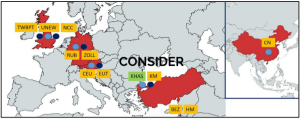
The Notre Dame Cathedral is widely regarded as the most beautiful example of French Gothic architecture, which includes innovative use of the rib vault and buttresses, colored stained glass rosettes, and sculptural decorations. Construction of the church began in 1160 and continued for a century.
“Notre Dame represents a literary heritage that appeals to the whole world, as well as architectural, cultural, and religious heritage,” said UNESCO Director-General Audrey Azoulay, stating that damage assessment will be done as soon as possible: “We are already in contact with experts who will assess the damage, we will protect what can be preserved. We will evaluate the measures that can be taken in the short and medium-terms.”
The assessment would be undertaken with the authorities concerned, including national, local, site management, and church officials, to develop an appropriate plan to avoid further damaging the site and recover the original elements. Subsequently, UNESCO would accompany and support the authorities in rescuing, rehabilitating, and rebuilding the damaged heritage site based on accurate archival material, photos, films, historical documentation, plans, and drawings.
Source: https://whc.unesco.org/en/news/1956
Photograph: Livio Garuccio © UNESCO
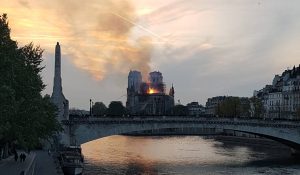
The opening ceremony of the UNESCO Chair on Management and Promotion of World Heritage Sites: New Media and Community Involvement was held at Kadir Has University on Wednesday, January 7. UNESCO Director-General Irina Bokova also attended the opening ceremony on the campus.
Please click to view the text of the speech titled “Safeguarding the Past for a Better Future for All” delivered at the opening ceremony by UNESCO Director-General Irina Bokova.




Projects
Title: “A Jerusalem Database: Architecture and Design in Modern Times,” Bezalel Academy of Arts and Design, Jerusalem
Purpose and Scope: The project’s primary purpose is to establish a database that will bring together the diverse materials dealing with the planning and design of Jerusalem. These materials include urban plans, architectural plans, maps, photographs, and documents. The project is based on the initial work done by scholars and other researchers, including at the Bezalel Academy. It is available in national and regional archives, scanned in high quality, and scientifically cataloged. A proposed dedicated website will allow free computer access to each archive separately and provide background information about the sustainable development of Jerusalem, including references to the cultural heritage.
Team:
Prof. Dr. Yonca Erkan
Assoc. Prof. Salih Bıçakcı
Prof. Dr. Füsun Alioğlu
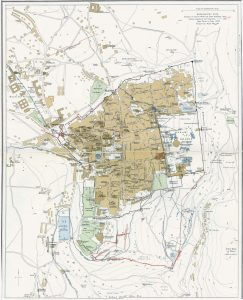
Photograph: “Modern Jerusalem 1915”, https://commons.wikimedia.org/